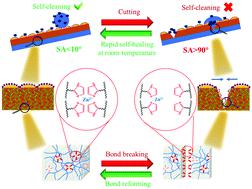当前位置:
X-MOL 学术
›
Soft Matter
›
论文详情
Our official English website, www.x-mol.net, welcomes your feedback! (Note: you will need to create a separate account there.)
Recovery of the self-cleaning property of silicon elastomers utilizing the concept of reversible coordination bonds.
Soft Matter ( IF 3.4 ) Pub Date : 2020-08-18 , DOI: 10.1039/d0sm01264e Yuxing Shan 1 , Zhi Zhou 2 , Haoming Bai 2 , Ting Wang 2 , Lili Liu 2 , Xiuli Zhao 3 , Yawen Huang 1
Soft Matter ( IF 3.4 ) Pub Date : 2020-08-18 , DOI: 10.1039/d0sm01264e Yuxing Shan 1 , Zhi Zhou 2 , Haoming Bai 2 , Ting Wang 2 , Lili Liu 2 , Xiuli Zhao 3 , Yawen Huang 1
Affiliation

|
Stretchable elastomers with superhydrophobic surfaces and self-cleaning abilities are fabricated for use in wearable electronics. However, scratches or ruptures are inevitable on these elastomers, thus deteriorating their self-cleaning ability. To solve this problem, in this work, we explored the ability of a self-healing silicon elastomer to recover its self-cleaning property. A cross-linked silicon elastomer (Zn-IC-PDMS) was fabricated by incorporating imidazole-zinc coordination bonds. The superhydrophobic Zn-IC-PDMS surface was synthesized by sequentially spraying polystyrene (PS) and silica particles on it to form a micro/nano complex structure. Our study shows that the surface of the elastomer exhibited a high water-contact angle (CA) (155°), low sliding angle (SA) (∼3°), and self-cleaning ability. In addition, the surface rapidly recovered its self-cleaning ability at room temperature after ruptures had been formed across the elastomer. SEM images and photographs revealed that the recovery of the self-cleaning ability was attributed to the self-healing behavior of the Zn-IC-PDMS.
中文翻译:

利用可逆配位键的概念恢复硅弹性体的自清洁性能。
具有超疏水表面和自洁能力的可拉伸弹性体被制造用于可穿戴电子产品。但是,这些弹性体不可避免地会产生划痕或破裂,从而使它们的自清洁能力恶化。为了解决这个问题,在这项工作中,我们探索了一种自愈硅弹性体恢复其自洁性能的能力。通过结合咪唑-锌配位键来制备交联的硅弹性体(Zn-IC-PDMS)。通过依次在其上喷涂聚苯乙烯(PS)和二氧化硅颗粒以形成微/纳米复合结构,合成了超疏水Zn-IC-PDMS表面。我们的研究表明,弹性体表面表现出高的水接触角(CA)(155°),低的滑动角(SA)(〜3°)和自清洁能力。此外,在弹性体上形成破裂后,表面在室温下迅速恢复了其自清洁能力。SEM图像和照片表明,自清洁能力的恢复归因于Zn-IC-PDMS的自修复行为。
更新日期:2020-09-23
中文翻译:

利用可逆配位键的概念恢复硅弹性体的自清洁性能。
具有超疏水表面和自洁能力的可拉伸弹性体被制造用于可穿戴电子产品。但是,这些弹性体不可避免地会产生划痕或破裂,从而使它们的自清洁能力恶化。为了解决这个问题,在这项工作中,我们探索了一种自愈硅弹性体恢复其自洁性能的能力。通过结合咪唑-锌配位键来制备交联的硅弹性体(Zn-IC-PDMS)。通过依次在其上喷涂聚苯乙烯(PS)和二氧化硅颗粒以形成微/纳米复合结构,合成了超疏水Zn-IC-PDMS表面。我们的研究表明,弹性体表面表现出高的水接触角(CA)(155°),低的滑动角(SA)(〜3°)和自清洁能力。此外,在弹性体上形成破裂后,表面在室温下迅速恢复了其自清洁能力。SEM图像和照片表明,自清洁能力的恢复归因于Zn-IC-PDMS的自修复行为。



























 京公网安备 11010802027423号
京公网安备 11010802027423号